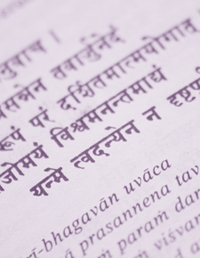Life
Debating the California Text Book Controversy

Hinduism Treated Unequally In California Textbooks
|
In India, an official who publicly affirms his Hindu identity would be stigmatized as “non-secular,” while almost any serious American presidential candidate (Republican or Democrat) feels compelled to assert a good Christian or Jewish identity with great pride. In America, it is a liability for public officials to be seen as not going to church regularly. In India, it is a liability to be seen as a devout Hindu among the modern (Westernized) Indians who maintain a safe distance from Hinduism. While the Indian government’s faith-based initiatives give the largest chunk of social funding to its minority religions (i.e. Christian and Islamic groups), the American government’s faith-based funding goes predominantly to Judeo-Christian groups. In other words, secularism and pluralism in America are not practiced at the expense of its majority religion, while in India Hinduism is undermined in the name of secularism. While Religious Studies is the most popular humanities discipline in American colleges, it is virtually absent in Indian universities, because of the Indian interpretation of secularism. The American Academy of Religion has 13,000 academic scholars of Religion, with sub-groups in various religious specialties. Very few AAR academic scholars of Hinduism identify themselves as practicing Hindus whereas a large percentage of Judaism, Christianity and Buddhism academic scholars are practitioners of those faiths. This under-representation in the case of Hinduism is partly due to India’s failure to supply qualified academic scholars in Hinduism Studies. Indians trained in social sciences have only a superficial education in Religious Studies, largely based on the imported interpretations of colonialists, evangelists and foreign-funded human rights campaigns. Many scholars in South Asian Studies adopt paradigms from English language writings that implicitly treat the West’s experiences as being universal. Trendy Western “theories” from the Post-Enlightenment milieu are often parroted by Indian intellectuals as a route to becoming a “whitened liberal.” Some scholars are implementing the agendas of Christian evangelists in India, Communist Party of India, and funding agencies linked to the US government and/or its “human rights” proxy agencies. These scholars seek credibility in the eyes of peers and the mainstream, well-funded Western agencies that can make or break careers. Their personal stakes include grants, tenure, prestigious projects and official committees. Hence, there is no significant “home team” representing Indian culture in the academy in the same manner as other major cultures and religions are represented. California school textbook biases against Hinduism: The recent California Department of Education hearings on sixth-grade textbook portrayals of religions and cultures have put the spotlight on the politics of identity negotiation in America. There is a clash between the Hindu Diaspora and a group of academic scholars claiming to be “the experts” on Hinduism. The latter are neither specialists in Religious Studies nor do they understand the politics of identity formation of immigrants in American history. The table below compares how California textbooks treat Hinduism and other major religions. Every religion has both positive and negative aspects, and someone has to choose which information to present to children. For instance, every religion needs to improve its treatment of women, minorities and those of other religions. Yet every religion also has great exemplars and textual references to inspire good citizenship. Every religion has beliefs that cannot be proven in a scientific manner using empirical evidence, thereby making it imperative that such beliefs should be explained consistently across all faiths. Every religion’s own leaders project a positive self-image, while there are differing views of those who are on the outside, especially those who hold a grudge against a given religion for whatever reason. Each religion has its “enemies” and its “victims.”
The question then becomes: What is appropriate to be taught to the 11-year old school children in California, who often have very short attention spans, and whose tightly packed curriculum has precious little time allotted to the study of other cultures? California’s official educational standards contain policies on this important question and require that, “No religious belief or practice may be held up to ridicule and no religious group may be portrayed as inferior,” and that, “Textbooks should instill a sense of pride in every child in his or her heritage.” These standards must be applied equally and consistently to all religions. As the table below demonstrates, the textbooks do not comply with the California standards when it comes to Hinduism. For instance, the textbooks say that Hinduism considers women to be inferior to men, but ignore biases against women in Islam, Christianity and Judaism. The textbooks focus on Hindu atrocities against certain groups, but do not point out that Islamic, Christian and Jewish societies have similar problems. The clergy in Islam, Christianity and Judaism are treated as credible experts and their religious texts are assumed to be stating historical facts, while Hindu texts are depicted through the pejorative lenses of critics.
To remedy this, some Hindu American groups and individuals did what Islamic, Jewish and Christian groups have been doing for many years: they reviewed the textbooks and initiated dialogue with the educational authorities who hold public hearings every six years in order to update textbooks. While the activism by Islamic and Christian groups drew no protests from scholars, similar activism by Hindus is being virulently attacked by some American scholars from prestigious colleges who brought in a bandwagon of Indian scholars eager to impress them. Most of these academics are not experts of religion, do not even belong to the Hinduism Unit of the American Academy of Religion, and claim their authority largely on their academic affiliations. The emphasis of the academicians’ counter-attack was not on the contents of the textbooks, on the official standards published by California, nor on the philosophy of education for our children. Instead, they attacked the people involved on the Hindu side, calling them “fascists,” “fundamentalists,” “nationalists,” “chauvinists,” and so forth. They tried to link these groups to violence overseas with sensationalized warnings to the California educators that their proposed amendments would encourage international terror. In other words, scholars who claim to be defenders of intellectual freedom and teachers of critical inquiry fell short on both counts in their own conduct. I do not agree with many of the changes petitioned by the Hindu groups. My issue is with the prejudice with which Hindus are being treated as compared to all others. Hindu petitions not treated equally: The following table shows that while all religions have their own lobby groups advocating changes, only the Hindus are attacked by these scholars. Furthermore, the California authorities, in a move which is now being challenged legally, heard a parade of anti-Hindu voices as “expert witness,” while there were no similar dissenting voices invited to criticize Islam, Christianity or Judaism. The scholars fighting the Hindu Diaspora frantically arranged to fly in witnesses who testified about the horrors of Hinduism, while no similar witnesses were brought to testify against the horrors of Islam, Christianity or Judaism. Only in the case of Hinduism was the politics from the mother country dragged into the California proceedings. The fact is that Hinduism is a world religion with followers in many parts of the planet besides India, and the social-political problems in India do not reflect on Hindus elsewhere such as the millions of Euro-Americans practicing yoga/meditation who claim Hindu or quasi-Hindu identities or the second-generation Indian Americans.
Political correctness towards non-Hindus only: While attempts are being made to teach about “Hindu horrors” against minorities, the same scholars are not lobbying to include “Islamic genocides,” in South Asia, “Islamic terrorism” worldwide, or “Christian holocausts” of Native Americans: The non-Hindu religions are coddled with political correctness and “sensitivity.” South Asia experts also know that Islam is a major South Asian religion, that it has more followers in South Asia than anywhere else in world, and that South Asian based Islam (i.e. in Pakistan-Afghanistan) has bred international terrorism. Therefore, to be true to their field of study, South Asian Studies scholars should apply the same “human rights” criteria to depict Islam in textbooks as they do to Hinduism. While these scholars champion sympathetic portrayals of minorities in India, they do the opposite in the case of Hindu minorities in America. Scholars should respect the mandate of California’s Social Studies Standards, that “Textbooks should instill a sense of pride in every child in his or her heritage.” In this capacity, textbooks should also include Hinduism’s major contributions to America: yoga, vegetarianism, the transcendentalist literary movement in the 19th century, and the many influences on American pop music, cuisine, film, dance, etc. “Human rights” used as a weapon of imperialism: Like all other traditional societies, Indian society can be seen as a “patient” that needs to be cured of maladies. But academic activists argue that Indian society should be “exposed” in America. However, they have failed to answer the following questions: Are Western institutions qualified to “cure” Indian society? What is the past track record of Western powers intervening in third-world domestic issues? What accountability do they have as “doctors”? Does the West have a superior human rights record? Are human rights definitions and case selections biased? Are Western agendas constructing categories of “cultural crimes”? Do Indian globe-trotting activists have personal vested interests? Young children exploited as pawns: The sixth-grade classroom is the right wrong to prosecute an American minority culture or a foreign nation. Among these students, perhaps less than one percentage will pursue careers as Christian evangelists slandering Hinduism to convert, or as government officials using “human rights” as a weapon to gain leverage against India. For this tiny number of potential specialists, there will be opportunities in higher studies to embark upon a comprehensive study of India’s positive and negative social qualities. Challenging history is one thing, but intentionally undermining self-respect at an impressionable age is a form of psychological child abuse. The political activism of a cartel of elitist scholars is invading innocent children: It harasses Indian students in class who feel embarrassed and ashamed of their ancestry, especially since American society valorizes identities and traditions. It handicaps the non-Indian students who will grow up to work in a world in which India must be taken seriously and not dismissed as a patient to be cured by the West. Rajiv Malhotra is a public intellectual living in Princeton, N.J., heads the Infinity Foundation. |
|||||||||||||||||||||||||||||||||||||||||||||||||||||||||||||||||||||||

 Comparing Indian and American secularism:
Comparing Indian and American secularism: Academicians smear Hindu participation in the hearings:
Academicians smear Hindu participation in the hearings: